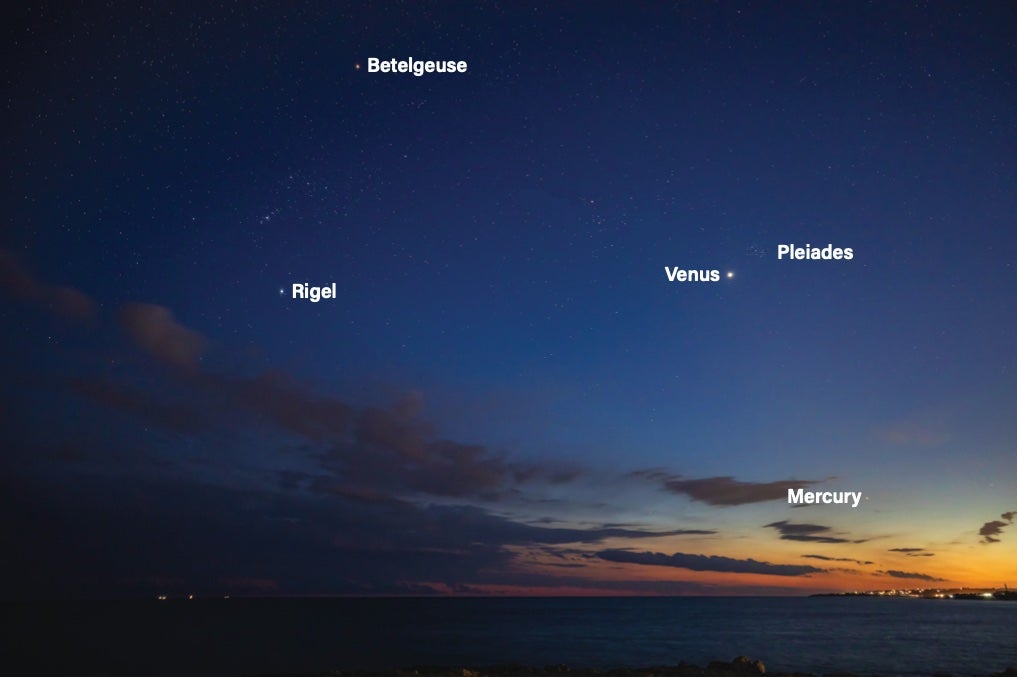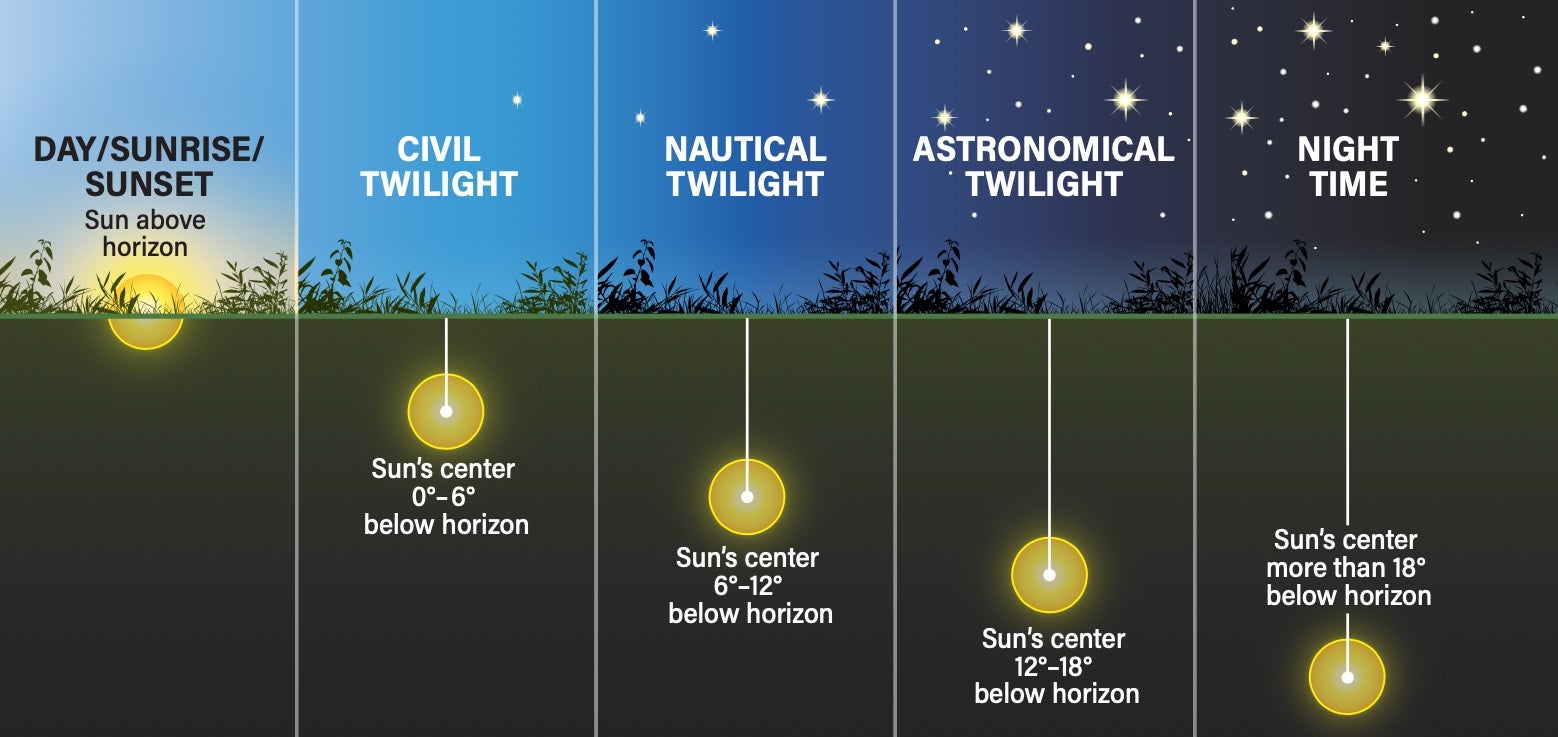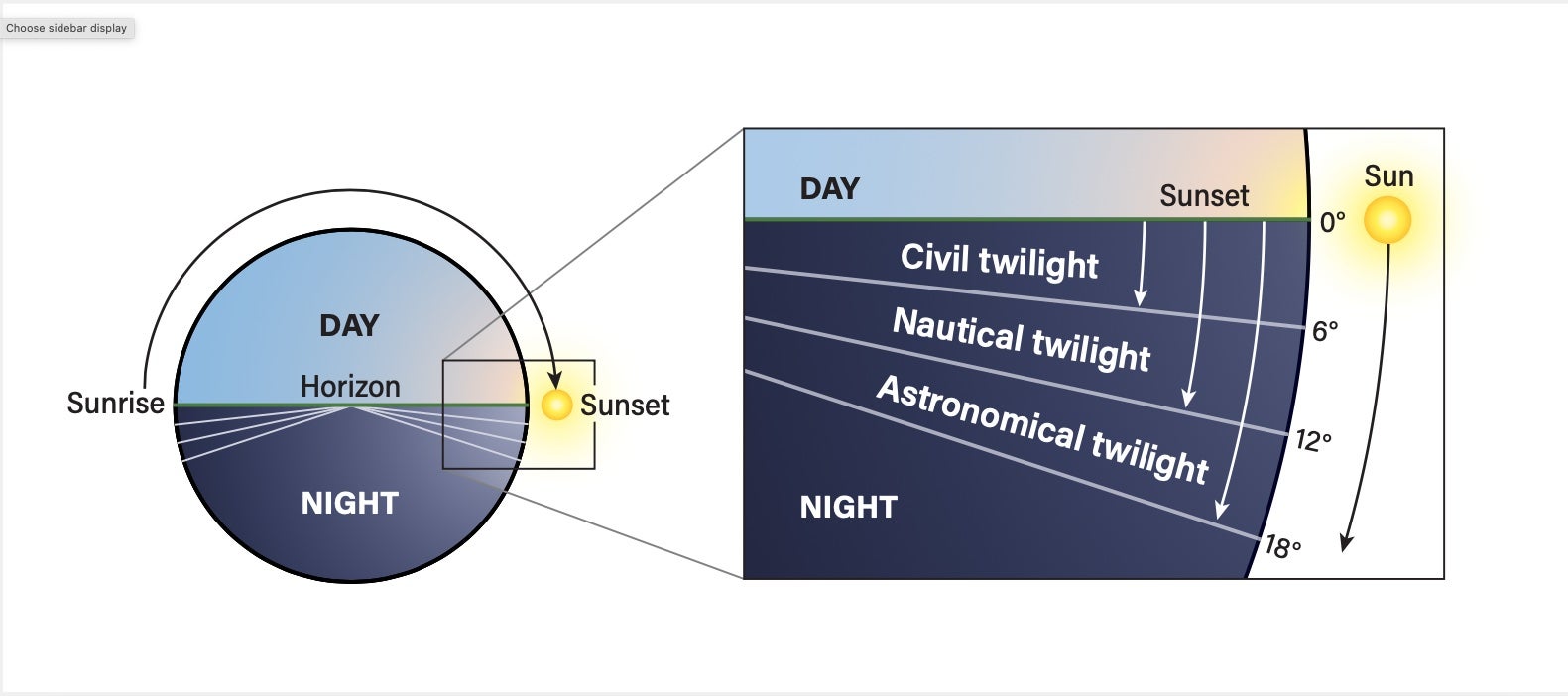
Twilight is a time when sunlight and Earth’s atmosphere intermingle to produce wonderful effects. But with the anticipation of setting up equipment and making plans for observing, we often forget to watch one of nature’s most beautiful spectacles, the time of transition from our busy day into the vibrant night.
What’s more, understanding twilight in its different stages helps to define how we see the sky at its best. Whether you’re an early riser or have stayed up all night, learning the three kinds of twilight will ensure you can catch the radiant atmospheric light show.
Scattered light
On a clear day, the sky can appear an intense and beautiful blue. This results from a complex interaction of sunlight and air molecules. The visible portion of the Sun’s light represents only a fraction of the solar spectrum: With its energetic short wavelength, blue light is scattered more easily by dust and air molecules, such as oxygen and nitrogen, than redder light. As a result, the sky looks blue in every direction. This effect is known as Rayleigh scattering.
However, the bright blue of the daytime sky seems to fade if you look toward the horizon. This is because you’re looking through more of the atmosphere at low altitudes, so sunlight travels through more air molecules and scatters even more.
As the Sun sets, this scattering effect is intensified. Now most of the Sun’s light is traveling through even more of the atmosphere and blue light is further scattered away, leaving the red and orange colors. Both the Sun and the horizon start to take on a reddish-orange hue.
There are other effects at play here, too. Our atmosphere is made up of layers consisting of different densities and temperatures. These distort and refract the Sun’s light unevenly, and can even cause the Sun to look flattened as it sets. When the Sun is just on the horizon, the light from its lower limb refracts more strongly than the light from the top of the Sun, creating the illusion of a flattened orb. (The same effect can flatten the look of the Full Moon as well.)
If conditions are just right, a brief flash of emerald may appear at the top of the flattened Sun as it sinks below the horizon. This occurs because Earth’s atmosphere acts as a prism, refracting the light and splaying out its colors. The short wavelengths of violet and blue appear slightly above the Sun, while red is consigned below the horizon. The momentary green flash can result because the human eye is most sensitive to green light — but to avoid serious harm, be sure never to stare directly at the Sun.

In twilight
Once the Sun has set, turn and face the east to witness one of the most beautiful events of twilight. A few minutes after the Sun disappears, Earth’s shadow begins to rise. Each time Earth’s shadow appears, its distinct round shape can be seen. In fact, it was through multiple lunar eclipse observations that Aristotle inferred — more than 2,000 years ago — that Earth is a sphere from its arclike shadow on the Moon.
As evening twilight progresses, a pink/red hue becomes visible just above Earth’s shadow. Sunlight is still passing through the upper atmosphere and encounters suspended dust particles and water droplets, which scatter the long wavelengths of red light. This time is referred as the anti-twilight arch or the Belt of Venus. It is named so because in the past, writers said that the belt could cause passion and love; the pink and red hues can certainly inspire wonder.
But twilight is not solely an evening phenomenon. It occurs both after the Sun sets and before it rises. In fact, astronomers recognize three different types of twilight: civil, nautical, and astronomical. Civil dusk, or evening civil twilight, begins when the Sun disappears below the western horizon and ends when the Sun’s center is exactly 6° below the horizon. Conversely, civil dawn, or morning civil twilight, starts when the Sun’s center is exactly 6° below the eastern horizon. Because these precise moments can’t be defined based solely on observations, they are calculated mathematically.
Civil dusk and civil dawn are meaningful for several reasons. Both these periods have not only astronomical but also cultural and religious significance. Judaism provides a striking example: The Sabbath begins at sundown when candles are lit and services start. This tradition stems from the book of Genesis, wherein the creation story can be translated to, “There was evening, and there was morning.”
In the evening, nautical twilight starts once civil twilight ends, and it culminates when the Sun is 12° below the horizon. Conversely, nautical dawn, or morning nautical twilight, begins when the Sun lies 12° below the eastern horizon. The term nautical arises because long ago, sailors out at sea depended on stars for navigation.
Evening astronomical twilight begins once the Sun’s center is 12° below the horizon. For most people, this period appears like night. From a good site, the sky looks dark and full of stars. So, you might ask, if the sky appears so dark, why bother defining this last period of twilight? During astronomical twilight, Earth’s atmosphere can refract sunlight, scattering some skyward. But when the Sun reaches 18° below the horizon, the sky is truly dark. We’re immersed in pure night. Faint astronomical objects are visible in all their glory. Later, when the Sun reaches 18° below the eastern horizon, astronomical dawn begins and the truly dark sky begins to disappear.
The three types of twilight are defined through mathematical equations relating to the position of the Sun. Their timing and duration can vary greatly depending on two main factors: where you are on Earth and the time of year, which is directly related to the Sun’s position on the ecliptic (the orbital plane of Earth around the Sun). The ecliptic is tipped 23½° with respect to the celestial equator (the same plane as the equator on Earth). Depending on the date and the observer’s latitude, the Sun may appear to set at a steep or a shallow angle relative to the horizon. For example, at Earth’s equator, the Sun always rises roughly due east and sets roughly due west, and is directly overhead (90° high) at midday. Because the Sun sets and rises perpendicular to the horizon at the equator, civil twilight lasts only about 24 minutes each day of the year.
In other locations, the angle at which the Sun slides below the horizon increases or decreases depending on the season. The summer solstice twilight lasts longer than the twilight at the winter solstice. Closer to the North and South poles, twilight is affected even more. The Arctic and Antarctic circles experience a period of prolonged twilight, sometimes lasting weeks. At latitude 68° north or south, depending on the season, the Sun may not rise or set at all.

Treasuring twilight
Poets, painters, and photographers have long treasured the mellow light of twilight, when the sky softens and deepens into a glow, or gently brightens as sunrise approaches.
Howard Washington Thurman, a prominent author and philosopher, wrote of twilight as “a time of pause when nature changes her guard. All living things would fade and die from too much light or too much dark, if twilight were not.









